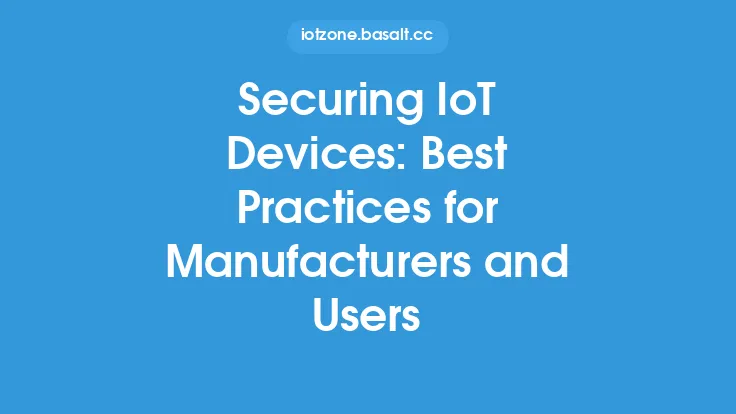The increasing number of Internet of Things (IoT) devices has led to a growing concern about their physical security. As these devices become more pervasive and interconnected, the risk of tampering and unauthorized access also increases. To mitigate this risk, manufacturers and designers are incorporating tamper-evident and tamper-resistant designs into their IoT devices. These designs aim to prevent or detect unauthorized physical access, ensuring the integrity and security of the device and its data.
Introduction to Tamper-Evident Designs
Tamper-evident designs are mechanisms that detect and indicate when an IoT device has been physically accessed or tampered with. These designs are crucial in preventing unauthorized access to sensitive components, such as microcontrollers, memory, or cryptographic modules. Tamper-evident designs can be implemented using various techniques, including:
- Seals and tapes: Using tamper-evident seals or tapes to cover screws, connectors, or other access points. If someone attempts to access the device, the seal or tape will be broken, indicating tampering.
- Sensors and detectors: Integrating sensors or detectors that monitor the device's environment and detect any changes, such as temperature, humidity, or vibration.
- Logging and auditing: Implementing logging and auditing mechanisms that record any access or changes to the device's configuration or data.
Introduction to Tamper-Resistant Designs
Tamper-resistant designs, on the other hand, are mechanisms that prevent or hinder unauthorized physical access to an IoT device. These designs are designed to make it difficult or impossible for an attacker to access sensitive components or data. Tamper-resistant designs can be implemented using various techniques, including:
- Encapsulation and potting: Encapsulating or potting sensitive components in a hard, tamper-resistant material, such as epoxy or resin.
- Secure packaging: Using secure packaging materials, such as tamper-evident bags or boxes, to protect the device during shipping and storage.
- Anti-tamper screws and fasteners: Using anti-tamper screws or fasteners that are difficult to remove without specialized tools.
Implementing Tamper-Evident and Tamper-Resistant Designs
Implementing tamper-evident and tamper-resistant designs requires a thorough understanding of the device's architecture, components, and potential attack vectors. Manufacturers and designers should consider the following best practices when implementing these designs:
- Conduct a thorough risk assessment: Identify potential attack vectors and vulnerabilities in the device's design and architecture.
- Select appropriate materials and components: Choose materials and components that are resistant to tampering and can detect or prevent unauthorized access.
- Implement multiple layers of security: Use a combination of tamper-evident and tamper-resistant designs to provide multiple layers of security.
- Test and validate the design: Thoroughly test and validate the design to ensure that it is effective in preventing or detecting tampering.
Benefits of Tamper-Evident and Tamper-Resistant Designs
The benefits of tamper-evident and tamper-resistant designs are numerous and significant. These designs can help prevent unauthorized access to sensitive data and components, reducing the risk of data breaches and cyber attacks. Additionally, these designs can help ensure the integrity and authenticity of the device and its data, which is critical in applications such as industrial control systems, medical devices, and financial transactions.
Challenges and Limitations
While tamper-evident and tamper-resistant designs are effective in preventing or detecting tampering, there are challenges and limitations to their implementation. For example:
- Cost and complexity: Implementing tamper-evident and tamper-resistant designs can add cost and complexity to the device's design and manufacturing process.
- Trade-offs: There may be trade-offs between security and other design considerations, such as performance, power consumption, or usability.
- Evolving threats: The threat landscape is constantly evolving, and new attack vectors and techniques may emerge that can bypass or compromise tamper-evident and tamper-resistant designs.
Future Directions
As the IoT continues to grow and evolve, the importance of physical security and tamper-evident and tamper-resistant designs will only increase. Future directions for research and development include:
- Advanced materials and technologies: Developing new materials and technologies that can provide enhanced tamper-evident and tamper-resistant capabilities.
- Artificial intelligence and machine learning: Using artificial intelligence and machine learning to detect and respond to potential tampering or security threats.
- Standards and regulations: Establishing standards and regulations for the design and implementation of tamper-evident and tamper-resistant designs in IoT devices.
Conclusion
In conclusion, tamper-evident and tamper-resistant designs are critical components of IoT device security. These designs can help prevent or detect unauthorized physical access, ensuring the integrity and security of the device and its data. By understanding the benefits, challenges, and limitations of these designs, manufacturers and designers can create more secure and reliable IoT devices that can withstand the evolving threat landscape. As the IoT continues to grow and evolve, the importance of physical security and tamper-evident and tamper-resistant designs will only increase, driving innovation and advancement in this field.





